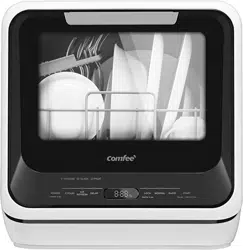Documents: Go to download!
- Owner's manual - (English)
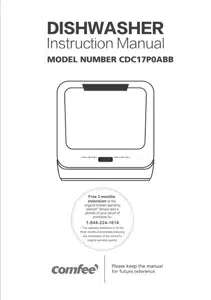
- QUICK START GUIDE
- GETTING TO KNOW YOUR APPLIANCE
- INSTALLATION
- USING YOUR DISHWASHER
- WASH CYCLE SELECTION
- MAINTENANCE AND CLEANING
- TROUBLESHOOTING TIPS
Table of contents
User Manual Comfee CDC17P0ABB Dishwasher
QUICK START GUIDE
Please read the entire manual for detailed operating instructions.
Connecting to Power Supply
The power required is 120VAC 60Hz, 10Amp circuit.
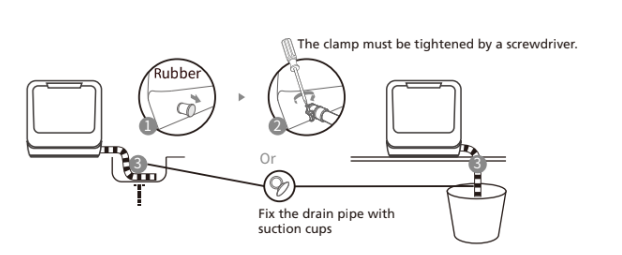
Drain hose installation
Place the end of the drain Hose into a sink or bucket.

Adding Water to the Tank
Note: Before adding water, you need to press the power button to turn on the diswasher .There are two ways to add water into the tank:
- Add water into the tank automatically by connecting inlet hose to the tap.
- Open the cap and slowly add water into the tank manually by using water container.
IMPORTANT:
The water tap symbol will be on if there is not enough water in the tank. Add water until the unit beeps rapidly for 3 seconds and is off, which means the tank is filled.

Prep the Dishware
Remove the large residue on the dishware and glasses before placing into the dishwasher.
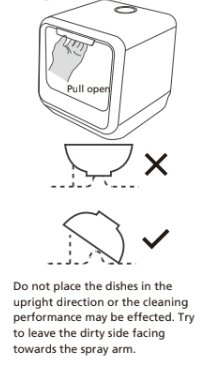
Loading The Dishwasher
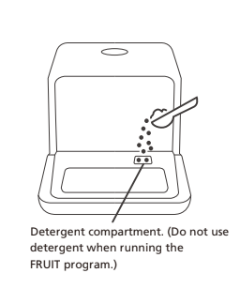
Starting The Dishwasher

GETTING TO KNOW YOUR APPLIANCE
IMPORTANT:
Before using this dishwasher for the first time and to get the best performance, read these instructions.
Dishwasher features
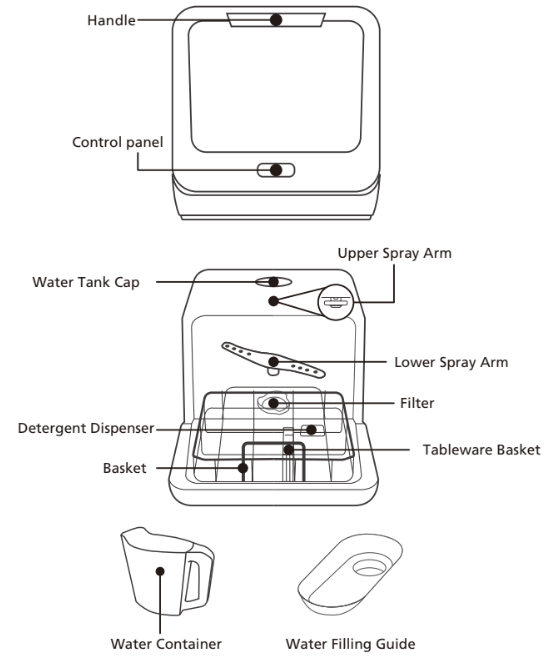
INSTALLATION

Attention
The installation of the pipes and electrical equipments should be done by professionals.
Installation preparation
Positioning the Appliance
The dishwasher is equipped with water supply and drain hoses that can be positioned to the right or the left to facilitate proper installation.
About Power Connection

Electrical Requirements
Please look at the rating label to know the rating voltage and connect the dishwasher to the appropriate power supply. Individual,properly polarized and grounded 10-amp (minimum) branch circuit fused with 10-amp (minium) time-delay fuse or circuit breaker.
Electrical Connection
Ensure the voltage and frequency of the power being corresponds to those on the rating plate. Only insert the plug into an electrical socket which is grounded properly. If the electrical socket to which the appliance must be connected is not appropriate for the plug , replace the socket, rather than using adaptors or the like as they could cause overheating and burns.
Water Connection

- Take the existing aerator off your faucet.
- Screw the faucet adapter onto (or into) the faucet tap. Check for leaks (Use Teflon tape
- Take the existing aerator off your faucet.
- Attach the quick connect onto the faucet adapter by pulling down the locking collar. Then pull up the locking collar to fix the connection.
- Slowly open the hot water line and check for any sign of water leaks at all hose connections.
IMPORTANT: Please confirm whether the supplied adapter is suitable for your faucet tap. If not, please contact our customer service where adapter is available for purchase.
Connection of drain hoses

- Remove the rubber stopper.
- Fix the drain pipe with the back pipe of the machine.The interface is fitted with clamps and tightened with a screwdriver.
- Place the free end of drain hose into a sink or bucket.Use the suction cup to hold the hose in place.(Note: the hose will shift when water is running if not secured)
Caution
The drain hose must be correctly fitted to avoid water leaks. Ensure that the water drain hose is not kinked or crushed.
USING YOUR DISHWASHER
Loading The Dishwasher
Recommendation
- All items to be washed should be marked "dishwasher safe".
- Use only dish detergent designed for automatic dishwashers, hand dishwasher soap will create foam and require significant clean up and issues with the dishwahser.
- For delicate items, select a program with lower temperatures.
- CAUTION: Do not take glass and cutlery out of the dishwasher immediately after the program has ended. These items will still be very hot.
Items Not Recommended for Dishwasher Use
Not suitable for use:
- Cutlery with wooden, horn, china or mother- of-pearl handles
- Plastic items that are not heat resistant, older cutlery with glued parts that are not temperature resistant
- Bonded cutlery items or dishes
- Pewter or copper items
- Crystal glass
- Steel items subject to rusting
- Wooden items
- Items made from synthetic fibres
Limited suitability:
- Some glasses can become dull after a large number of washes.
- Silver and aluminium have a tendency to discolour during washing.
- Glazed patterns may fade if washed frequently.
Dishwasher Loading Tips
- Items such as cups, glasses, pots/pans, etc. load face downwards.
- Curved items, or those with recesses, should be loaded at a slant so that water can run off.
- All utensils are stacked securely and can not tip over.
- All utensils are placed in the way that the spray arms can rotate freely during washing.

- Place cups,deep bowls,and pans face down
- Load items in a way that the dirty surface faces the center of the dishwasher
- Position items such that they will not collect water of have puddles of water on top
- Load long and/or sharp cutlery horizontally on the cutlery tray
- Avoid nesting dishes for best results(example two spoons together)
- Ensure items do not touch or move/wobble in the basket,this can cause damage to your dishes
- Do not allow items to extend below the dishwasher rack,this could cause and interference with the wash arm.
- Do not overload your dishwasher. If the water can not get to your dishes from the bottom or top wash results may be poor.
Loading The Baskets
Position the dishes and cookware so that they will not get moved by the spray of water.
Recommended loading layouts below
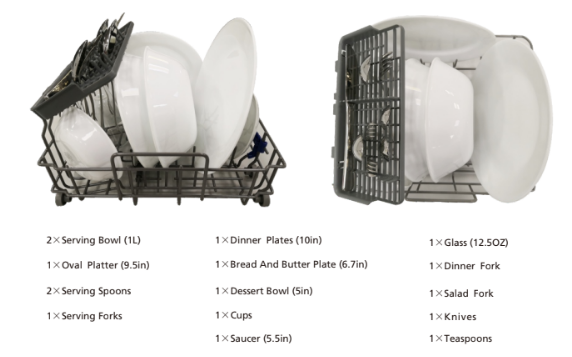
Recommended loading layout with 1 serving bowl and 2 settings personal tableware.
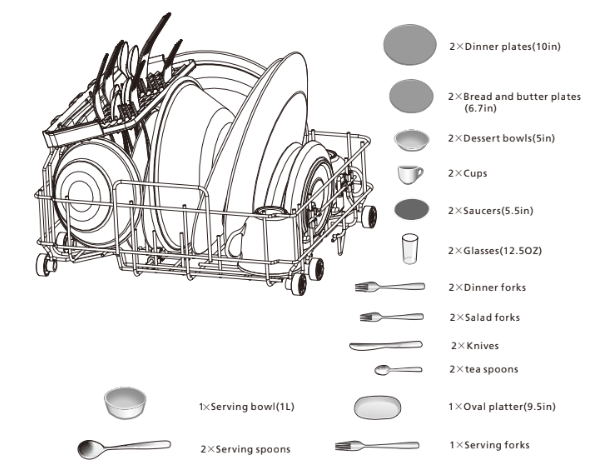
Folding Down The Rack Shelves
The tines are used for holding plates and a platters. They can be lowered to make more room for large items, such as large tableware, the fruit basket, or baby bottle rack.
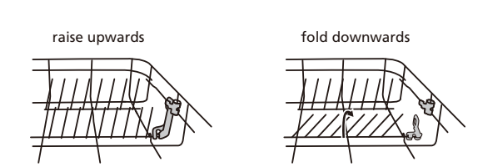
Loading The Detergent
This product not support rinse aid. Only add detergent.
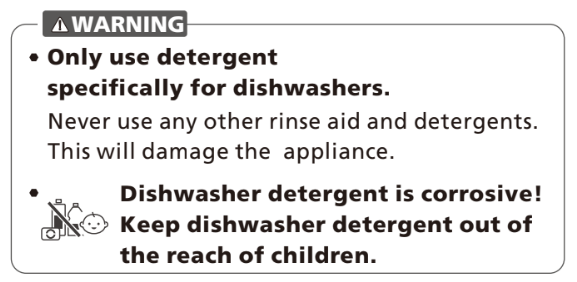
Detergent Tablets
Detergent tablets of different brands dissolve at different speeds. For this reason some detergent tablets will not dissolve and develop their full cleaning power during short programs. Therefore use long programs when using detergent tablets, to ensure the detergent tablet dissolves completely.
Detergent
Adding detergent
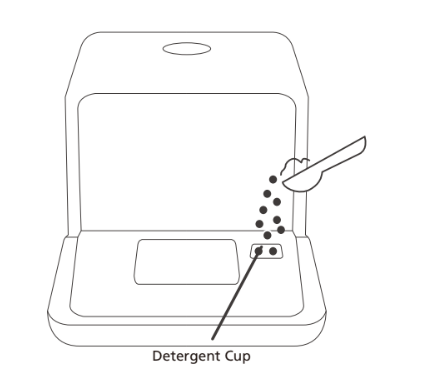
WASH CYCLE SELECTION
Wash Cycle Programs
The table below shows which programs are best for the levels of food residue on them and how much detergent is needed. It also show various information about the programs.

Turning On The Appliance
Starting a wash cycle...

Change The Program
A wash cycle can only be changed if it has been running for a short time otherwise, the detergent may have already been released and the dishwasher may have already drained the wash water. If this is the case, the dishwasher needs to be reset and the detergent dispenser must be refilled. To reset the dishwasher, follow the instructions below:
- Press and hold Start button for more than 3 seconds,the machine will be in stand by state.
- Press CYCLES button to select the desired program.
- Press the Start button.


Forget to add a dish?
A forgotten dish can be added within the first 10 minutes of the cycle.If this is the case, follow the instructions below:
- Open the door a little to stop the washing.
- After the spray arms stop moving, you can open the door completely.
- Add forgotten dishes.
- Close the door.
- Press the Start button, the dishwasher will start working after 10 seconds.

End Of Wash Cycle
When the cycle has finished, the buzzer of dishwasher will sound 8 seconds,then stop.Turn off the appliance using the ON/OFF button, shut off the water supply and open the door of the dishwasher. Wait a few minutes before unloading the dishwasher to avoid scald. The dishes and utensils are still hot and more susceptible to breakage. They will also dry better.
- Switch Off the Dishwasher
- S witch off the dishwasher by pressing the ON/OFF button.
- Turn off the water tap!
- Open the door carefully

Forced Tank Draining Operation
In standby mode, you can press and hold NORMAL button + RAPID button for 3 seconds simultaneously to drain the water tank.
MAINTENANCE AND CLEANING
Filter System

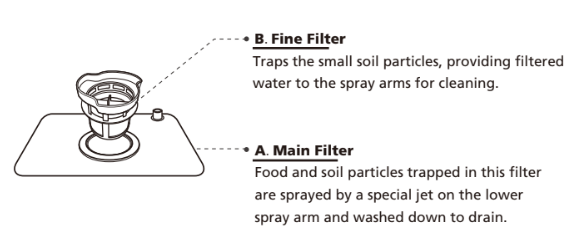
Step 1: Turn the filter assembly clockwise, then lift it up.

Step 2: Lift fine filter up and seperate it from the main filter.
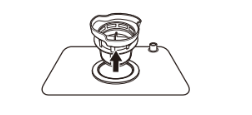
Step3: Clean all of filter elements under running water to remove food soils.

- Inspect the filters for blockages every time the dishwasher has been used.
- By unscrewing the coarse filter, you can remove the filter system. Remove any food remnants and clean the filters under running water.

Dishwasher Care
Cleaning The Door

Protect against freezing
Protect the dish washer from freezing temperatures.If the dishwasher will experience freezing temperature please flow the below procedure:
- In standby mode,press and hold DELAY button + AUTO OPEN button for 3 seconds simultaneously to drain the water tank.
- Unplug electrical power to the dishwasher.
- Turn off the water supply and disconnect the water inlet pipe from the back of the dishwasher.
- Drain water from the inlet pipe and dishwasher (use a pan to catch the water).
- Disconnect drain hose,and drain water from hose and back of dishwasher (place a catch pan under connection before disconnecting to catch water).
- Reconnect the water inlet pipe and drain hose to the back of the dishwasher.
- Remove the filter at the bottom of the tub and use a sponge to soak up water in the sump.

Cleaning The Spray Arms
The spray arms can be easily removed for periodic cleaning of the nozzles to remove possible clogging. Wash them under running water and carefully replace them in their seats, checking that their rotary movement is in no way impeded.
Grasp the middle of the spray arm, pull it upwards to remove it. Wash the arms under a jet of running water and replace it carefully to its seat. After reassembly, check that the spray arms rotate freely and are snapped in securely.
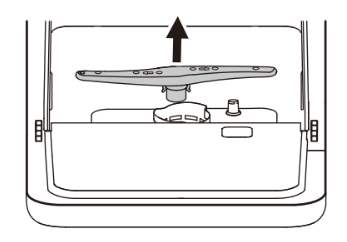
Dishwasher Maintenance
After Every Wash
After every wash, turn off the water supply to the appliance and leave the door slightly open so that moisture and odors are not trapped inside.
Cleaning Best Practices
When Left Unused
It is recommend that you run a wash cycle with thedishwasher empty and then unplug from power, turn off the water supply and leave the door of the appliance slightly open. This will help the door seals last longer and prevent odors from forming within the appliance.
Moving the Appliance
If the appliance must be moved, try to keep it in vertical position to prevent water from draining from the dishwasher.
If transporting a long distance drain water from the interior tank and hoses:
- Drain water from interior tank In standby mode,press and hold NORMAL button + RAPID button for 3 seconds simultaneously to drain the water tank.
- Disconnect water inlet and drain hoses from the back of the dishwasher (place a catch pan under the connections before removing the hoses to catch any water ).
- Remove the filter at the bottom of the tub and use a sponge to soak up water in the sump.
TROUBLESHOOTING TIPS
Before calling for service
Reviewing the charts on the following pages may save you from calling for service.
1. Dishwasher doesn't start
- Fuse blown, or the circuit break tripped - Replace fuse or reset circuit breaker. Remove any other appliances sharing the same circuit with the dishwasher
- Power supply is not turned on - Make sure the dishwasher is turned on and the door is closed securely. Make sure the power cord is properly plugged into the wall socket.
- Error code: E1. Water pressure is low - Check that the water supply is connected properly and the water is turned on.
- Door of dishwasher not properly closed - Make sure to close the door properly and latch it.
2. Water not pumped from the dishwasher
- Kinked or crushed drain hose - Check the drain hose.
- Filter clogged - Check filters.
- Kitchen sink clogged - Check the kitchen sink to make sure it is draining well. If the problem is the kitchen sink that is not draining , you may need a plumber rather than a serviceman for dishwashers.
4. Drain hose routing is too high
- The dishwasher drain hose should not be installed higher than 39 1/4"(1m) from the surface that the dishwasher is sitting on to prevent performance issues.
5. Suds in the tub
- Incorrect Detergent/Soap - Remove all of the dishes from the dishwasher.Scoop out as much of the suds as you can with a plastic container. Add a cup of either olive ail or white vineger,and run normal wash for a few minutes,and force a drain.Repeat as necessary until the foam is cleared, then run a complete Normal Cycle with no dishes.
- Spilled rinse-aid - Always wipe up rinse-aid spills immediately.
6. Stained tub interior
- Detergent with colorant may have been used - Make sure that the detergent has no colorant.
7. White film on inside surface
- Hard water minerals - To clean the interior, use a damp sponge with dishwasher detergent and wear rubber gloves. Never use any other cleaner than dishwasher detergent otherwise, it may cause foaming or suds.
8. Rust stains on cutlery
- The affected items are not corrosion resistant - Avoid washing items that are not corrosion resistant in the dishwasher.
9. Knocking noise in the dishwasher
- A spray arm is knocking against an item in a basket - Interrupt the program and rearrange the items which are obstructing the spray arm.
10. Rattling noise in the dishwasher
- Items of crockery are loose in the dishwasher - Interrupt the program and rearrange the dishware.
11. Knocking noise in the water pipes
- Water hammer in household piping - This has no influence on the dishwasher function. If in doubt, contact a qualified plumber.
12. The dishes are not clean
- The dishes were not loaded correctly - See notes in Loading & unloading your dishwasher.
- The program was not powerful enough - Select a more intensive program.
See other models: CDC17P2AWW CDC17P0AWW CFO-BG12SS PORTABLE WASHING MACHINE CO-A101A_BK
